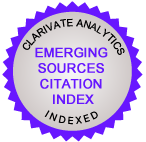Cinegraf Magazine (1932-1937): specialized criticism, conservative modernism and the search for a national image.
-
Iván Morales
 ivanmorales@gmail.com
ivanmorales@gmail.com
Downloads
Abstract
The following article analyses Cinegraf magazine, published in Argentina between April 1932 and December 1937 when its director, Carlos Alberto Pessano, retired to dedicate himself exclusively to the technical direction of the Argentinian Cinematographic Institute. I aim an integral approach to the magazine, focusing on the Director‘s editorials, critical texts inside the magazine and the key that images play in this editorial project. Cinegraf is a fundamental object in this period for two main reasons. On one hand, it is a pioneer in the development of a specialized film criticism. On the other, it is a fundamental player in the incipient Argentinian film industry, which the magazine will try to steer from its first steps. In this sense, it debated with local productions, maintained a contradictory relationship with mass culture and imagined a specific visual project for the national image.
Palabras Clave
AGUILAR, Gonzalo; JÉLICE, Emiliano (2010): Borges va al cine. Buenos Aires, Libraria.
BALLENT, Anahí; GORELIK, Adrián (2001): “País urbano o país rural: La modernización territorial y la crisis”, en CATARUZZA, Alejandro (Dir.): Crisis económica, avance del Estado e incertidumbre política (1930-1943). Buenos Aires, Sudamericana, pp. 143-200.
BELTON, John (1974): The Hollywood Professionals, Volume 3. Howard Hawks, Frank Borzage, Edgar G. Ulmer. New York, A. S. Barnes & Co.
BONTEMPO, Paula (2012): Editorial Atlántida. Un continente de publicaciones, 1918-1936 (Tesis doctoral). Buenos Aires, Universidad de San Andrés.
BORDWELL, David; THOMPSON, Kristin; STAIGER, Janet ([1985] 1997): El cine clásico de Hollywood. Barcelona, Paidós.
D‘LUGO, Marvin (2007): “Gardel, el film hispano y la construcción de la identidad auditiva”, en BERTHIER, Nancy y SEGUIN, Jean-Claude (Eds.): Cine, nación y nacionalidades en España. Madrid, Casa de Velázquez.
DUMONT, Hervé ([1993] 2009): Frank Borzage: The Life and Films of a Hollywood Romantic. North Carolina, McFarland & Company.
GOMERY, Douglas (2005): The Coming Of Sound. A History. New York, Routledge.
GRAMUGLIO, María Teresa (2013): Nacionalismo y cosmopolitismo en la literatura argentina. Rosario, :e(m)r;.
HUYSSEN, Andreas ([1986] 2002): Después de las gran división. Modernismo, cultura de masas, posmodernismo. Buenos Aires, Adriana Hidalgo.
KRIGER, Clara (Dir.) (2003): Páginas de cine. Buenos Aires, Archivo General de la Nación y Museo del Cine “Pablo C. Ducrós Hicken”.
KRIGER, Clara (2010): “Gestión estatal en el ámbito de la cinematografía argentina (1933-1943)”. Anuario del Centro de Estudios Históricos “Prof. Carlos S. A. Segreti”, nº 10, pp. 261-281.
LIDA, Miranda (2015): “Estética, cultura y política en la revista Criterio (Argentina, 1928-1936)”. Nuevo Mundo Mundos Nuevos, pp. 1-16.
LUCHETTI, María Florencia; RAMÍREZ LLORENS, Fernando (2005): “Intervención estatal en la industria cinematográfica. 1936-1943: El Instituto Cinematográfico del Estado”, en AA.VV.: Cuaderno de Cine Argentino, Gestión estatal e industria cinematográfica. Buenos Aires, INCAA.
MARANGHELLO, CÉSAR (2000): “Cine y Estado. Del proyecto conservador a la difusión peronista”, en ESPAÑA, Claudio (Dir.): Cine Argentino. Industria y Clasicismo 1933-1956, Vol. II. Buenos Aires, Fondo Nacional de las Artes, pp. 160-183.
MALLEA, Eduardo ([1937] 1981): Historia de una pasión argentina. Buenos Aires, Sudamericana.
MALTBY, Richard (2012): “The Production Code and the Mythologies of ‘Pre-Code‘ Hollywood, en NEALE, Steve (Ed.): The Classical Hollywood Reader. New York, Routledge, pp. 237-248.
OUBIÑA, David (2016): “El noble experimento (Sobre la película imposible de Victoria Ocampo y Sergei Eisenstein)”. Estudios curatoriales, Nº 4.
ROMERO, José Luis ([1976] 2010): Latinoamérica. Las ciudades y las ideas. Buenos Aires, Siglo XXI.
SARLO, Beatriz ([1993] 2003): Borges, un escritor en las orillas. Buenos Aires, Seix Barral.
SILVESTRI, Graciela (1999): “Postales argentinas”, en ALTAMIRANO, Carlos (Ed.): La Argentina en el siglo XX. Buenos Aires, Ariel, pp. 111-135.
SKLAR, Robert (1975): Movie-Made America. A Cultural History of American Movies. New York, Random House.
SPADACCINI, Silvana (2012): “Carlos Alberto Pessano, de la opinión a la gestión”. Imagofagia, nº 5, s/p.
TELL, Verónica (2006): “Latitud-Sur: coordenadas estético-políticas de la fotografía moderna en Argentina”, en WESCHLER, Diana (Ed.), Territorios de dialogo, España, Mexico y Argentina 1930-1945. Buenos Aires, Fundación Mundo Nuevo, pp. 195-201.
TERÁN, Oscar (2008): Historia de las ideas en la Argentina. Buenos Aires, Siglo XXI.
THOMPSON, Kristin (2005): Herr Lubitsch Goest To Hollywood. German and American Film After World War I. Amsterdam, Amsterdam Universitiy Press.
Similar Articles
- Leandro González, Argentine cinema in Brazil: integration, cooperation and competition , Perspectivas de la Comunicación: Vol. 13 No. 2 (2020): July-December
- Diego Germán Vigna, Being an author and making archive on the web. On speeds and ways of intervention in digital cultural magazines and social platforms from the Argentine context , Perspectivas de la Comunicación: Vol. 10 No. 1 (2017): Enero - Agosto
- Natalia Raimondo Anselmino, Alejandro Sambrana, Ana Laura Cardoso, José Rostagno, Paratextual and paralinguistic resources in the fanpages of the Argentine newspapers Clarín and La Nación. Attributes of press discourse in social networking sites , Perspectivas de la Comunicación: Vol. 12 No. 2 (2019): July - December
- Francisco-Julián Martínez-Cano, Begoña Ivars-Nicolás, Alba-María Martínez-Sala, Dual ubiquity: basis for the effectiveness of VRCinema as a prosocial tool. Analysis of Hunger in L.A. and After Solitary. , Perspectivas de la Comunicación: Vol. 13 No. 1 (2020): January - June
- Joan Marimon Padrosa, Editing and montage in International film and video: theory and technique , Perspectivas de la Comunicación: Vol. 10 No. 1 (2017): Enero - Agosto
- Judith Jansma, Populism and literature: Mapping the debate on Houellebecq‘s Soumission [Bilingual edition: Spanish – English] , Perspectivas de la Comunicación: Vol. 11 No. 1 (2018): january - august
- Omar Rincón, Amparo Marroquín, The contributions of the popular Latin American to the pop mainstream of communication [Bilingual edition: Spanish – English] , Perspectivas de la Comunicación: Vol. 11 No. 2 (2018): September - December
- Yánder Castillo Salina, Viviana Muñiz Zúñiga, Alicia de la Caridad Martínez Tena, The agenda-setting theory. Epistemological criticism and qualitative deepening from anthropological study. , Perspectivas de la Comunicación: Vol. 14 No. 1 (2021): January - June
- Esteban Andrés Zunino, Lorena Recalde Cerda , Gabriela Baquerizo, Argentine political leaders on Twitter. A study about the midterm elections in 2017 , Perspectivas de la Comunicación: Vol. 12 No. 2 (2019): July - December
- Marina Acosta, Feminist activism on Instagram. The case of the National Campaign for the Right to Safe and Free Legal Abortion in Argentina , Perspectivas de la Comunicación: Vol. 13 No. 1 (2020): January - June
You may also start an advanced similarity search for this article.
Downloads
Published
How to Cite
Issue
Section
License
- Proposed policy to offer Open Access Journals
Authors who publish with this journal agree to the following terms:
a) Authors retain copyright and grant the journal right of first publication with the work simultaneously licensed under a Creative Commons Attribution Attribution (CC -BY 4.0) ![]() that allows others to share the work with an acknowledgement of the work's authorship and initial publication in this journal.
that allows others to share the work with an acknowledgement of the work's authorship and initial publication in this journal.
b) Authors are able to adopt licensing agreements for the non-exclusive distribution of the journal's published version of the work (for example, to post it to an institutional repositories or publish it in a monograph), with an acknowledgement of its initial publication in this journal.
c) Authors are allowed and encouraged to post their work online (For example, in institutional repositories or on their website) prior to and during the submission process, as it can lead to productive exchanges and increase the citation of published work (See The Effect of Open Access).











